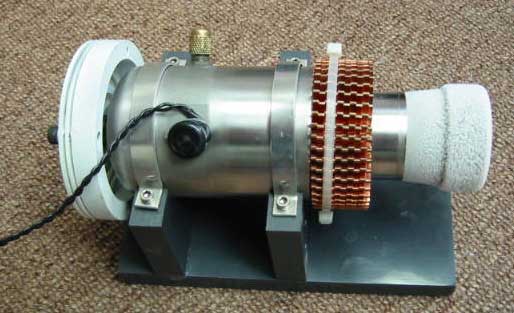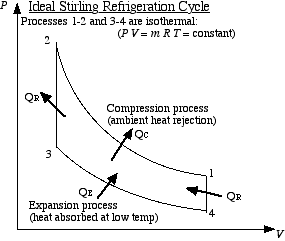|
|
|
|
 Sterling Cycle Cooling - Wave of the future? Sterling Cycle Cooling - Wave of the future?
|
|
Date Posted: Dec 31 2002
|
|
Author: Airspirit
|
|
|
|
|
Posting Type: Article
|
|
Category: High End Cooling
|
|
Page: 1 of 1
|
Article Rank: from 1 Readers
Must Log In to Rank This Article from 1 Readers
Must Log In to Rank This Article
|
|
|
|
|
Note: This is a legacy article, imported from old code. Due to this some items on the page may not function as expected. Links, Colors, and some images may not be set correctly.
|
|
|
Sterling Cycle Cooling - Wave of the future? By: Airspirit
|
|
|
|
|
The Next Generation of Cooling - Stirling Cycle
Pro/Geeks! By: Airspitirt 12/31/02
|
|
|
This article was submitted via the Pro/Geeks! service ProCooling runs for its readers and cooling geeks like you. Monthly we offer prizes for those readers or just overall geeks that can write the best articles/reviews and want them posted on ProCooling. For more info on how you can get some free stuff, please check this link!
|
|
We currently have a number of ways to cool off the hot parts inside of our computer systems. These fulfill a range of uses and abilities, and each have their benefits and drawbacks.
The basic cooling mechanism is the heat sink. This tried and true method of heat removal is ideal for any part where heavy cooling isn't necessary, moderate airflow is available, and silence is desired. With no moving parts, there is no noise.
One step further is the heat sink w/ fan (HSF). These cool much better than unblown heat sinks, as the air is constantly circulated through it, keeping temperatures lower. Since there is a moving part (the fan), noise comes into play, ranging from near silent to ear-shattering.
Another large step forward is water cooling. Through use of heat exchangers, the heat from a component can be drawn away via a coolant loop to be dissipated at another point. Invariably, this is much more effective for cooling than using a HSF, and in many circumstances can also reduce the noise from the system. In some systems, fans can be eliminated completely, but there is still noise from the pump to deal with.
Currently, the cutting edge of cooling technology involves the use of Peltier effect coolers, and phase change refrigeration systems. These technologies range from simple evaporation coolers such as bongs and water towers, to simple HSF cooled low power peltiers, to elaborate water cooled systems that involve peltiers, refrigeration units, and elaborate thermal management techniques. Unfortunately, there are many parts involved, and with all of these technologies, the price of failure would spell catastrophe. Further, due to the fact that these technologies drop the temperatures well below ambient, heavy insulation is often needed to prevent component damage.
I won't be dealing with any of those methods in this article. There is one more method of cooling that will be coming to age in the coming years: Stirling Cycle Cryogenics. The drawbacks to all current sub-ambient cooling methods (besides basic evaporation cooling, which doesn't reach far below ambient in and of itself), is that they all require massive amounts of power. Anyone who has struggled to feed power to a 226W peltier can tell you that they are some thirsty SOBs, and phase change units are not a whole lot better. Plus, with phase change units you deal with loud compressors, fans, and other components that can become an annoyance to a avid PC user.
Stirling Cycle Coolers have a minimum of moving parts. Typically, a free piston model has, by definition, only two: a piston to compress the internal gas (helium! talk about safe!), and a displacer to move the gas from the cold side to the hot side, where the heat is dissipated. A small unit is being developed by a company out of the Netherlands called Global Cooling that is designing a unit that can cool a 200L insulated refrigerator from ambient of 25C down to 5C inside with only 8-9W of power input in practical silence.
|
|
|
|
This is a graphic demonstration of the Global Cooling refrigerator model I was describing. You have to love the frosty buildup on the cold "plug", eh?
|
|
|
|
|
|
This will drop your coolant temperature around 20C when the cold "plug" is submerged in your coolant, and the hot side is cooled by heat sinks. How slick is that? To push it even further into the realm of possible sub-zero coolant temperatures, you may think about water cooling the hot side with a custom made block (like what some people use on their Iwaki pumps), bringing the cold side down an equal temperature amount. Instead of a large phase change unit, you could stick one of these puppies (they weigh about 4 lbs.) in your res, and ditch your radiator completely. The design of this is different than the picture above. This design is the free piston design I described above. The pulley on the end is a flywheel for the electric motor. The motor turns, moving a piston in a compression chamber. This moves a displacer inside by the pressure, which in turn compresses the other side, and draws heat out of it when the cycle reverses. In the end, you have a perfectly good heat pump that is much more suited for use in cooling applications than a peltier, and draws less power than both that and a phase change unit. Being that there are only two moving parts and the system is hermetically sealed, it will give you years of trouble-free service. Remember, this particular unit runs on less than 9W of power to give you that cooling .... Here is a diagram of the inside of this unit, provided by Global Cooling (compiled from an animation on their site):
|
|
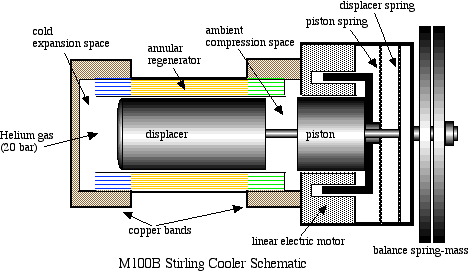 |
|
|
|
The Stirling cycle can be drawn as follows:
|
|
|
|
This shows the full range of the system. First heat is pumped out through the first compression stroke. As the displacer moves toward the cold end, gas is shuttled from the cold end to the warm end. When the piston moves back, it pulls the displacer back with it, forcing expansion in the cold end, drawing heat from outside. Then the displacer moves back to the cold end and the cycle begins again. It is a real elegant system that is extremely efficient. Since there is no severe compression or friction anywhere in the system, there is little that will ever wear. Since it is sealed, there is no need for periodic maintenance. All in all, this could be the perfect cooling system. I'm not going to go into all the different design theories in this article, since I could easily fill a book with it all. You just need to Google "Stirling Cycle Engine" to get overloaded by the sheer
|
|
|
volume of information about this old and suddenly hot field.
As you can see, the possibilities of CPU cooling with these units is enormous. Not only can you get rid of a phase change system that draws as much as fifteen times the power use and immensely more noise for one of these, but as there are few moving parts, the life expectancy of one of these unit is immense. Plus, there are no risks of a toxic refrigerant being leaked into your home and melting your bones or some other horrible outcome, and most of these units can be ripped directly from the fridge they're built into and used as a cooling mechanism with little or no modification. Further, by varying the voltage from the standard 120VAC on this unit up to around 200VAC, in testing by Global Cooling, it would allow refrigeration of a 100W heat source to under -10C on this particular unit. A variac voltage modifier could be used to effect this change and overclock (you were waiting for that, right?) this cooling unit and all others like it, since of the two factors that determine cooling output (displacer speed and ∆T between the hot and cold sides), the displacer speed is the easiest and safest to adjust without damaging the unit. While Stirling engines love high temperature differentials, they are progressively more fragile and prone to failure if the hot side gets too hot. If the hot side was allowed to increase in temperature willy-nilly, you would risk your hardware. Therefore, by increasing the cooling on the hot side (good air cooling or water cooling) and changing the displacer shuttling speed through increasing AC voltage to the AC induction motor nearly all of these run off of, you will get much better performance than by running it stock with no added chance of wear or failure (if only CPUs were like that!!!). Since 3A variacs can be acquired for as little as $40 shipped, it isn't a huge investment on top of the engine to increase your cooling ability by about another ∆20C to the colder.
|
|
|
|
Another more complex method of hardcore Stirling cooling is as follows:
|
|
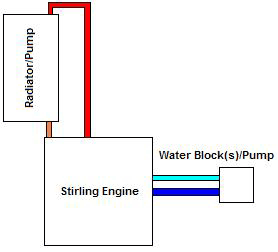 |
|
|
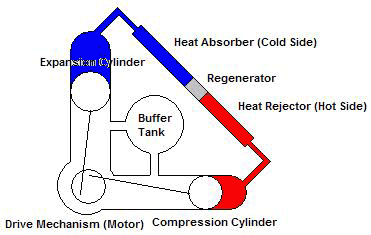 |
|
|
|
|
|
This would involve one simple water cooling loop to the block(s) in your system, and one radiator/fan loop to cool the hot side of the stirling unit. Unlike a submerged phase change coil application, this would completely isolate your hot flow from your cold flow to the CPU block. Also, this adds little extra complexity to your cooling loop. How it works is that there are four phases to this two cylinder stirling cycle (three moving parts): isothermal compression (heat rejection/loss), isovolumetric cooling, isothermal expansion (heat absorption/chiller) and isovolumetric heating. When the working fluid is changing at isothermal expansion, it absorbs heat from the outside on the heat absorber, drawing it from your CPU loop. When it is changing at isothermal compression, it rejects heat to the outside on the heat rejecter, releasing it into your radiator loop for dissipation into the ambient environment. Consider it a Peltier that doesn't sit on your processor, is 70%+ efficient, and doesn't use a ton of power. Further, it is suited for indirect cooling of the CPU loop, unlike a typical peltier unit.
The benefit of stirling cycle cooling is that they are suited for a wide band of temperature ranges, ranging from the 20C ∆T described above, to units designed to keep temperatures low enough to liquefy Nitrogen. I would like all the overclockers out there to think about that: LN2 performance all the time, not temporarily. If that doesn't give you a jolt in the pants, nothing will, though an application like that obviously couldn't use the typical coolants that even the most hardcore phase change users use in their systems. Even alcohols would snap freeze at those temperatures. Possibly a gas based heat pipe application could be used, though it would take more expertise than mine to design such a device.
There are a number of companies currently designing cheap stirling refrigeration units for retail markets. The ones currently available are way above the budget of all except the most rich (tens of thousands of dollars), and are used in commercial cryocooling applications and refrigeration. One such device being designed by Sanyo, similar to the dual piston model shown above, is capable of keeping a 500W heat source between -180C and -50C using power from a single 230V plug.
Another unit that is quite promising is a unit being designed by Sunpower that will keep a 5W heat load at around -200C when the hot side is kept at 40C (giant radiator or watercooler required), using only 95W of power! If that isn't sweet, I don't know what is! At higher heat loads the temperature raises, but you would still be under -70C (actual CPU temperature) regardless of your system's power. The price of the unit is a paltry $34,000 USD, but hey, you'll be keeping your computer at LN2 speeds permanently, right? Plus, the watercooling for the hot side is provided in the cost! The unit, without the cooling loop, is only 26 cm x 12 cm in size, for a nice and compact installation.
There currently is talk about small stirling cycle refrigeration engines being manufactured for fridges and freezers for under $100 USD. Global Cooling is just one of the companies dedicated to this field, and this is what we need to watch, folks. While by 2007, we should be able to buy cryocooling models like the one above for under $500 USD, it is the small stuff that should stay on our radar screens. Can you imagine adding $150 to the cost of your cooling system and getting a coolant temperature drop of over 25C? For many of us, it would give us cooling that many phase change coolers are getting at a fraction of the cost, and with little know-how. These cheaper, less powerful models are in many cases being field tested as you read this, and should be available within a year. In Europe, especially, there is a push for stirling cycle refrigeration units because of environmental laws that are starting to make traditional refrigerant disposal quite expensive and unwieldy.
Now, with all of that said, any stirling engine can be used as a cooling source. Most Stirling engines are currently in use as external combustion engines (the cold side is exposed to heat and the hot side is cooled by watercooling, typically) for power generation. Since all stirlings function in the same way (with variations in efficiency), by applying force to the motor instead of drawing force from it in electricity, it would turn a generator into a cooler. You could currently pick up one of these generators for as little as $1000 for a 300 kW generator. By removing the burn shrouding and the AC generation equipment, you can convert one of these into a cooler by bolting a watercooler to the hot end, installing an AC induction motor to the drive-shaft, and piping your system heat to the cold side in whichever way is most convenient. It will only be a matter of time until one of our rich, crazy, overclocking Japanese friends will wise up to this and do some wonderful things with system cooling. Until then, the majority of us will have to sit back and wait until refrigerator class Stirling Engines come onto the market before we can take advantage of this new and potentially revolutionary method of system cooling
|
|
|
|
| Random Forum Pic |
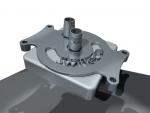 |
| From Thread: swiftech questions |
|
| | ProCooling Poll: |
| So why the hell not? |
|
I agree!
|
 67% 67%
|
|
What?
|
 17% 17%
|
|
Hell NO!
|
 0% 0%
|
|
Worst Poll Ever.
|
 17% 17%
|
Total Votes:18Please Login to Vote!
|
|






 Sterling Cycle Cooling - Wave of the future?
Sterling Cycle Cooling - Wave of the future?
 from 1 Readers
Must Log In to Rank This Article
from 1 Readers
Must Log In to Rank This Article
